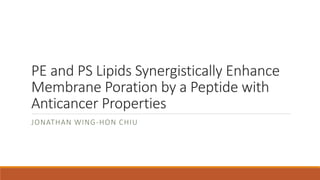
PE and PS Lipids Synergistically Enhance Membrane Poration
- 1. PE and PS Lipids Synergistically Enhance Membrane Poration by a Peptide with Anticancer Properties JONATHAN WING-HON CHIU
- 2. Polybia-MP1 (MP1) •Extracted from venom of Brazilian wasp Polybia paulista •Initial studies showed antimicrobial properties • Wide range of bactericidal activities (Gram-negative and positive) • Not hemolytic nor cytotoxic •Previous studies show selective inhibition of cancer cells • Bladder, prostate, and leukemic cells • MP1 was only cytotoxic against leukemic T lymphocytes • Healthy lymphocytes unaffected
- 3. MP1 Selectivity against Cancer Cells •Phospholipid distribution of cancer cell membranes are different to healthy cells •Phosphatidylserine (PS) is an anionic aminophospholipid • Found mainly in inner membrane leaflet •In apoptotic or cancer cells • PS found in outer monolayer
- 4. MP1 Molecular Mechanism •Anticancer mechanism still unknown • Lipid distribution •Studies on lipid vesicles containing PS • MP1 had high affinity and lytic activity •Recently, phosphatidylethanolamine (PE) lipids shown to be similar to PS • Inner for healthy cells • Outer for apoptotic and cancer cells
- 5. Aim of this Study •Establish the roles of PE and PS lipids in presence of MP1 on the structure and permeability of model membranes •Methods • Circular Dichroism (CD) • Quantify peptide-membrane binding • Fluorescence Spectroscopy • Establish leakage system • Atomic-Force Microscopy (AFM) • Show nanoscaled-pores caused by MP1
- 6. PS lipids significantly enhance peptide binding to the membrane •Four membrane conditions using PC,PE, and PS • Large Unilamellar Vesicles (LUVs) •Partition coefficient (Kp) from CD experiments • Show binding affinity • Huge difference with PS vs without PS •Results show that the presence of PS increased the binding of MP1 to the membrane by a factor of 7-8
- 7. Synergistic enhancement of GUV leakage kinetics by PE and PS lipids •Giant Unilamellar Vesicles (GUVs) with both PE and PS leaked CF probe twice as quickly •Further leakage of bigger probes measured • PE-containing GUVs leaked larger probes within seconds • Others much slower •Presence of PE significantly • Increase initial permeability • Formation rate of larger pore or membrane defects Leakage Markers •CF = 0.37 kDa •3k-CB = 3 kDa •10k-AF647 = 10 kDa
- 8. PE lipids significantly enhance pore size and membrane permeability •a) Measuring dye influx vs time after MP1 added • PC/PE/PS • Influx happened quicker • Larger dyes followed immediately after smaller CF dye • PC/PS • Much slower • Larger dyes lagged •b) Illustration and images to represent graph (a) • Time and % filled comparison
- 9. Direct imaging of peptide- induced pores by AFM •PC/PE/PS membranes pore sizes • 250 ± 110 nm in diameter •PC/PE • 290 ± 200 nm • But fewer number of pores •PC/PS • 54 ± 30 nm •PC • No pores even after 2h
- 10. Biophysical implications for MP1-lipid membrane interactions • Role of PS • Increase binding affinity of MP1 to the membrane • Allow MP1 to interact more effectively with other lipid components (PE) •Role of PE • 1) Increase permeability of the membrane • 2) Facilitates the formation of larger transmembrane pores to leak bigger and more cell components
- 11. Biophysical implications for MP1-lipid membrane interactions •Synergistic effects of PS and PE • PS – create many holes, but not large • PE – create large holes, but not many • Having both PS and PE create many large holes when MP1 is present •Other issues • Electrostatic and hydrophobic interaction between MP1 and other lipid bilayer components • MP1’s integration into lipid bilayer
- 12. Implications for the chemotherapeutic potential of MP1 peptides •Previous studies show • MP1 selectively inhibits numerous cancer cell lines • Cancer cell membranes have increased expression of PS and PE lipids on the outer layer •These results suggests a new mechanism to target cancer cells • In the future, modify peptides to optimize their selectivity, function, and properties
- 13. Implications for the chemotherapeutic potential of MP1 peptides •Some challenges • Chemotaxis for polymorphonucleated leukocytes -> inflammation • Potent antimicrobial activity (Gram-positive and –negative) •Future prospects • Use MP1 synergistically with other drugs • MP1 to disrupt membrane, then allow other drugs to enter the cell
- 14. Thank you! Q&A
